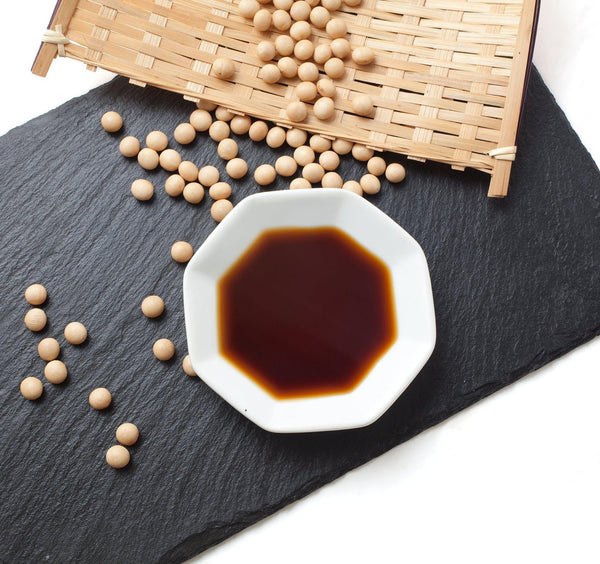
Jump to:
Soy sauce, or shoyu is one of the most indispensable Japanese condiments that can be found in every Japanese household. While many people opt for standard soy sauces like light or dark soy sauce, did you know that there is soy sauce that is more intense in flavor, darker in color, and thicker in texture? In this article, we’d like to introduce you to saishikomi shoyu or twice-brewed soy sauce. We’ll cover everything you need to know about this superb shoyu, including how it's made, how to enjoy it, how it compares to other kinds of shoyu such as the more common koikuchi dark soy sauce, and more.
What Is Saishikomi Shoyu?

Saishikomi shoyu is one of the main six types of soy sauce varieties in Japan. It is dark in color and rich in texture and flavor. Its richness and robustness are due to the fact that it is brewed for at least double the amount of time as koikuchi shoyu. It also requires twice as many raw materials (think: soybeans and wheat) to make. Saishikomi shoyu accounts for about 1% of all shoyu produced in Japan.
Where Does Saishikomi Shoyu Come From?
Saishikomi shoyu is thought to have originated in Yanai city, in Yamaguchi prefecture. However, these days, shoyu breweries throughout Japan are making their own versions of this special shoyu, so you can find it in virtually any region throughout the country. It is important to note that since saishikomi shoyu requires the use of more raw materials and more time to make, only smaller-scale shoyu breweries tend to specialize in making it.
Another interesting thing to note about saishikomi shoyu is the fact that these days, there is not a region in Japan that specifically specializes in making it. Unlike koikuchi shoyu which is popular in the Kanto region, or usukuchi shoyu which is popular in the Kansai region, saishikomi shoyu can be found throughout Japan made by a variety of shoyu artisans.
How Is Saishikomi Shoyu Made?

Saishikomi shoyu goes through a double-step fermentation process, but its first round of fermentation is exactly the same as standard koikuchi shoyu. In case you’re unfamiliar with how shoyu is made, soybeans and wheat are first mixed together before being combined with koji, a fermentation agent. These ingredients are mixed together and then saltwater is then added to the mixture, to make moromi. The moromi is then filtered and blended and the final product of this is what ends up as koikuchi shoyu. The process of making this shoyu takes around 6 months to one year on average.
In order to make saishikomi shoyu, the now prepared koikuchi shoyu must then be refermented, but any leftover moromi liquid acquired from making the first batch of shoyu is discarded, and the remaining raw materials are left to ferment without the addition of any extra saltwater. In this stage, even more soybeans and wheat are added to give the final shoyu product a deeper flavor. The fermentation vessel used to make saishikomi shoyu is up to the maker, but wooden barrels called kioke and stainless steel tanks are common options.
The second fermentation process of saishikomi shoyu takes at least one year, but many breweries let their saishikomi shoyu age further for two, three, or even four years. It really depends on the maker, but on average from start to finish, it takes at least two or three years to make true saishikomi shoyu.
Why bother making Saishikomi Shoyu?
After reading the above section, you may wonder why shoyu breweries even go through the hassle of making saishikomi shoyu, especially considering that it is a multi-year commitment. While yes, saishikomi shoyu is by far the least efficient shoyu to produce, the taste more than makes up for it. Ultimately saishikomi shoyu is a luxurious kind of soy sauce that has demand, so shoyu breweries continue to make it.
What Does Saishikomi Shoyu Taste Like?

Now that we’ve touched on the basics, you’re probably wondering what saishikomi shoyu actually tastes like. Saishikomi shoyu is often described as being much richer in flavor compared to the standard koikuchi shoyu. Its taste and aroma are thought to be perfectly balanced, while at the same time not being overly salty. All of the elements required for a balanced flavor - saltiness, sweetness, bitterness, acidity, and umami - are present in saishikomi shoyu’s flavor profile.
Is Saishikomi Shoyu salty?
Saishikomi shoyu’s twice brewing process and the use of double the ingredients to make it may lead people to think that it’s saltier than other soy sauces. However, that couldn’t be farther from the truth! If you’ve tried saishikomi shoyu before, then you’ll know that it actually tastes less salty than standard dark soy sauce.
The truth is that saishikomi shoyu contains around the same amount or less salt than standard koikuchi shoyu, with saishikomi at 14-16% salt content and koikuchi at 16-17% salt content. The double fermentation process of saishikomi shoyu does of course change its flavor, but it does not make it taste saltier.
How To Use Saishikomi Shoyu?

Saishikomi shoyu is recommended to be used as a dipping sauce for foods that are fatty or rich in flavor. (Think, red meat or fatty tuna sashimi). When it comes to pairing saishikomi shoyu with foods, there is an ideology that you should pair it with foods that also pair well with red wine.
Another great point about saishikomi shoyu is actually its viscosity. Since it is thicker in texture compared to conventional shoyu, it coats food nicely, allowing you to experience its flavor proportionately well with the food that you are eating it with.
If you want to try saishikomi shoyu out for yourself but don’t know how to use it, here are a few ideas:
- Use it as a dipping sauce for red meat or sashimi. You can add a little bit of wasabi or grated ginger to add a bit of a kick!
- Use it as a dipping sauce for gyoza or shumai.
- Mix saishikomi shoyu with a dab of wasabi, and sprinkle it over sliced avocado.
- Drizzle some saishikomi shoyu over vanilla ice cream for the ultimate sweet and savory pairing!
Can You Cook With Saishikomi Shoyu?

You can also cook with saishikomi shoyu, but it should only be used in small amounts. It is recommended to add it into dishes at the end of the cooking process, if you’re looking to give your dish a more intense flavor. It will greatly increase the depth of flavor in whatever dish you add it to. Add a splash of saishikomi shoyu to simmered dishes or curry, and see how the flavor instantly elevates.
Saishikomi Shoyu vs Koikuchi Shoyu
We’ve already touched on a few differences between saishikomi shoyu and koikuchi shoyu, but here are a few more differences between the two. Koikuchi shoyu is an everyday soy sauce that is especially useful for cooking. While it can also be used as a dipping sauce, it is not as robust in flavor as Saishikomi shoyu and it does not have as thick of texture, meaning that saishikomi shoyu wins in this category.
On the other hand, it is recommended not to use saishikomi shoyu in the same way that you would use an all-purpose soy sauce like koikuchi shoyu. This is because saishikomi shoyu is much stronger in flavor than conventional koikuchi shoyu, and if used in too large of amounts, its flavor will overpower the overall taste of what you’re cooking.
Saishikomi Shoyu vs Tamari Shoyu
This one is a bit trickier. In fact, saishikomi shoyu and tamari shoyu are the most similar in flavor, color, and texture compared to all of the other types of shoyu. They are also made in similar ways! (Well, at least tamari shoyu that is made using traditional brewing methods). The biggest difference lies in the ingredients used to make these two different types of shoyu. Tamari shoyu contains a higher amount of soybeans, and little-to-no wheat is involved in its production. Tamari shoyu is also slightly sweeter than saishikomi shoyu.
If you want to learn more about tamari shoyu, we have a whole article where we cover everything you need to know about it here.
Best Saishikomi Shoyu To Try?

Many people who are interested in Japanese cuisine or more artisanal Japanese shoyu may already be familiar with saishikomi shoyu but not know it. In fact, if you’ve tried the famous Tsurubishio Shoyu from Yamaroku, then you’ve already tasted saishikomi shoyu. Tsurubishio is indeed an undoubtedly tasty saishikomi shoyu. However, there are other shoyu breweries that specialize in making saishikomi shoyu that tastes just as good, if not better than Tsurubishio, yet these shoyu makers are virtually unknown outside of Japan. We’d like to give some of these breweries a voice and introduce some of our favorite saishikomi shoyu options below.
Suehiro, a shoyu brewery local to Tatsuno city in the Kansai region makes an exquisite saishikomi shoyu that our team members have all had the honor of trying. What truly makes their saishikomi shoyu special is that they use water from the local Ibo River in Tatsuno, which is known for having a soft texture and pure taste. The use of this water combined with the fact that their saishikomi shoyu only uses local ingredients really makes all the difference. The flavor is rich and all five senses of taste are present and perfectly harmonized. In fact, this is one of the most beloved kinds of shoyu among the Japanese Taste team!
Another great saishikomi shoyu option is the Fueki Kinbue Saishikomi Nama Shoyu. This particular saishikomi shoyu is fermented in a wooden barrel, which gives it a unique and complex taste. It is also classified as a nama shoyu, or raw soy sauce because its production process does not involve the use of heat. Because it is fermented without being heated, it has a different kind of umami flavor that cannot be found in other saishikomi shoyu.
Lastly, Kamebishi also makes their own saishikomi shoyu, and it’s also extremely tasty! Their saishikomi shoyu is brewed for three years which is already a huge indicator that it’s packed with flavor. It is also slightly less salty than other varieties of saishikomi shoyu but is suitable to be used on its own as a dipping sauce. Interestingly, Kamebishi recommends using this shoyu as an ingredient for the dipping sauce for tsukemen and grilled fish or eel.
Want to learn about other great Japanese soy sauces? Check out our recommendations here!
What do you think about saishikomi shoyu? Have you tried it before? If not, which variety do you want to try? We’d love to hear your thoughts, so let us know in the comments below.


0 comments